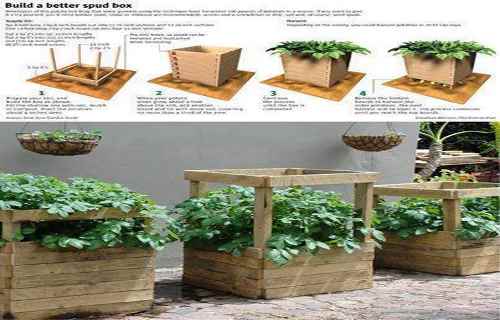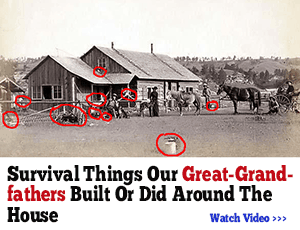Build Your Own Potato Growing Box (Effective Method to Produce a Large Quantity of Potatoes)
Don’t you mean potato grow box? Nope, that’s not a typo. As the areas of my garden devoted to perennials has gradually increased, the need to use the remaining space more efficiently has become more important. Using trellises and other vertical growing methods greatly help in this challenge.
Though my first attempts at growing potatoes the last couple of years has been successful, it took up a fair portion of the raised bed(s) they were growing in. This year, I am again doing another “first” – growing potatoes vertically. The “potato box” or “spud box” has become an effective method to produce a large quantity of potatoes in a small space. The idea is ingenious – forcing the potato plant to “stretch” upward as it grows allows more area of the plant to produce potatoes.
The potato “growing” box is just that – a series of frames that stack, or grow, as the potato plant grows. I like to look at the frames as resembling the floors of a building. In this project, our potato “building” will be six stories tall.
The list of things you’ll need:
1. Six – 2″ x 6″ x 8′ untreated wood boards
2. Two – 2″ x 2″ x 6′ wood studs (or one 12′ long stud)
Note: I actually went with 2×3’s instead of 2×2’s because they were straighter. For the purpose of this project, we’ll stick with 2×2’s to avoid confusion.
3. About 65 – 2 1/2″ long deck screws (I just got a 1-pound box of them – it’s less expensive. You’ll have extras, but you’ll probably need them later).
4. Drill and drill bits
Word of the day: Prepare! And do it the old fashion way, like our fore-fathers did it and succeed long before us, because what lies ahead of us will require all the help we can get. Watch this video and learn the 3 skills that ensured our ancestors survival in hard times of famine and war.
Skill Level:
Easy to intermediate
Construction:
1. Cut the two 2″ x 2″ x 6′ studs into four 33″ pieces (you’ll have a few inches left over).
2. Cut the six 2″ x 2″ x 8′ boards into 12 lengths of 21″, and 12 lengths of 24″.
3. Pre-drill 2 holes on each end of the 24-inch pieces, about 3/4″ from the edge. This will position the screws to go into the center of the cut side of the 21-inch pieces.
4. Screw two of the 24″ pieces, and two of the 21″ pieces together to form a “frame”.
5. Repeat STEP 4 five more times. This will give you a total of 6 frames. These six frames will stack on top of each other, creating your box.
6. Place one of the 2″ x 2″ x 33″ stud pieces to the inside corner of one of the frames. This frame will be the base (or the bottom floor) of the box.
7. Pre-drill two holes on the outside of this frame, so they align with the stud you placed in the corner of the frame. Here, the screws will anchor the stud into the corner of the frame in two spots.
8. Repeat STEP 7 for the remaining three inside corners of the frame. The base of the box will now look like an upside-down square table.
9. Slip one of the other frames onto the base frame, with the four “legs” being on the inside. These two “floors” will be the area we will plant in. Note: If you wish to dig into the ground to plant your seed potatoes, you can omit this step for now. I simply chose to start the potatoes inside the box, rather than digging into the ground below the box.
Planting & Growing:
10. Find the location (full sun preferably) for your box and clear away any sod, rocks or debris. Place the box into position.
11. Prepare the soil at the base of the box. You can use your existing soil if it has good drainage and has some organic matter already in it. Otherwise, potting soil, compost, or finely-chopped mulch can be added. I used a mix that was about 40% compost, 40% chopped leaves, straw and grass clippings, and 20% existing soil. I filled the “bottom two floors” with the mix, almost to the top edge of the frame.
12. Plant the seed potatoes about 3″-4″ deep, and cover with soil. I added a thin layer of larger leaves as a mulch.
13. When your potato plants are about a foot high, add another frame and fill it with more soil, covering no more than a third of the plant. Continue this process through the season, until the remaining frames have been added.
The Lost Ways is a comprehensive book that teaches you a variety of ways that our forefathers used to deal with different situations. The program teaches you survival mechanisms that does not require money. The fact is that the modern survival equipment is unreliable and ineffective. In fact with the techniques in this book, you can survive solely in a catastrophe that kills everybody.
Harvesting:
14. To harvest, remove the bottom frame’s boards to access the bottom layer of soil. When all of the potatoes have been removed from this level, replace the soil and reattach the boards. To harvest more potatoes, repeat those same steps with the second frame’s boards. And so on, and so on, until you’ve reached the top frame.
Enjoy the fresh spud greatness!
RELATED : Growing Potatoes in Straw: A Labor-Saving/Better Harvest Technique
SOURCE : vegetablegardener.com
The Lost Ways (Learn the long forgotten secrets that helped our forefathers survive famines,wars,economic crisis and anything else life threw at them)
Survival MD (Best Post Collapse First Aid Survival Guide Ever)
Backyard Innovator (A Self Sustaining Source Of Fresh Meat,Vegetables And Clean Drinking Water)
Blackout USA (EMP survival and preparedness)
Conquering the coming collapse (Financial advice and preparedness )
Liberty Generator (Build and make your own energy source)
Backyard Liberty (Easy and cheap DIY Aquaponic system to grow your organic and living food bank)
Bullet Proof Home (A Prepper’s Guide in Safeguarding a Home )
Family Self Defense (Best Self Defense Strategies For You And Your Family)
Survive Any Crisis (Best Items To Hoard For A Long Term Crisis)
Survive The End Days (Biggest Cover Up Of Our President)
Drought USA (Discover The Amazing Device That Turns Air Into Water)



step 14 is fucking NONSENSE, wtf do you even mean??!